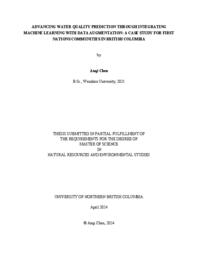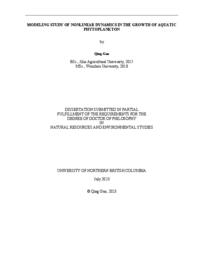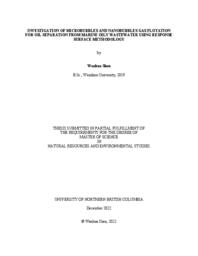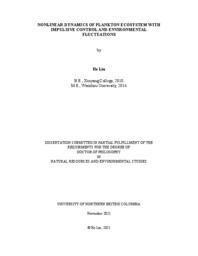Zhao, Min
Person Preferred Name
Min Zhao
Related Works
Content type
Digital Document
Description / Synopsis
Clean drinking water access is essential for public health and regarded as a scarce resource for Indigenous communities in rural and remote areas. In this research, a new iron and manganese prediction method based on Data Augmentation and Machine Learning Algorithms to be applied to drinking water in BC’s First Nation communities is reported. GAN based modelling and NIBS-NI based modelling were developed to investigate the effects of different data augmentation methods and predictors for iron and manganese prediction results. Reliable synthetic data was obtained through both data augmentation methods, allowing 4 machine learning algorithms to predict iron and manganese utilizing 3 and 5 physical properties respectively. Compared with RF, XGB, and DT machine learning models, the GBR model showed the strongest fitting ability and accurate predictions for both NI-BS-NI based modelling and GAN based modelling in predicting iron and manganese, with the Train R2 and Test R2 of two models nearing 1, and all the RMSE scores are below 0.06. The decision-making tool developed using GAN technology is considered to have greater application potential due to its ability to provide accurate predictions while requiring only 3 input physical parameters.
Origin Information
Content type
Digital Document
Description / Synopsis
Phytoplankton bloom has become a growing global concern in recent years due to the excessive growth of algae, causing significant negative impacts on aquatic ecosystem and threatening human health. Growing evidence suggests that algal blooms are a consequence of the interplay of various hydrodynamical, chemical, and biological processes in aquatic systems. The complexity and nonlinearity of aquatic ecosystems, and the complexity of climatic and hydrographic events, make interpreting and predicting the blooms a very challenging task. In recent years, many different strategies have been adopted to manage algal blooms. Among them, mathematical models are advantageous because they can capture the ubiquitous stoichiometric constraints for modeling species growth and interaction. Thus, mathematical models have been widely used to investigate the dynamics of phytoplankton growth. In this study, five mathematical models were developed based on population dynamics, ecological dynamics, dynamic modeling, and probability theory. The models were investigated theoretically and numerically in terms of the theory of partial differential equations, stochastic differential equations, impulsive differential equations, and numerical simulation. The objective of this dissertation research was to gain insight into plankton dynamics and explore potential management strategies for excessive algal growth in aquatic systems. The main results are presented as follows: Firstly, a nutrient-plankton model incorporating delay and diffusion was developed. The theoretical analysis revealed that delay can trigger the nutrient-plankton oscillation via a Hopf bifurcation. Especially, the stability switches for positive equilibrium occur with increasing delay, which indicates that delay can generate and suppress the unstable coexistence of species population. Numerical results reveal that the stability switches for positive equilibrium indeed exist in the model, and the homogeneous multiple periodic solutions, as well as chaos, can occur with different values of delay, which implies that the model exhibits delay-induced complex dynamics. Secondly, a stochastic Leslie-Gower phytoplankton-zooplankton model with prey refuge was developed. The dynamical analysis revealed the sufficient conditions for the persistence and extinction of plankton populations. The numerical simulations showed that environmental noise and prey refuge play a crucial role in the survival of plankton species. The results further demonstrate that prey refuge can enhance the oscillation range of phytoplankton population, but the variance of zooplankton tends to increase and then decrease as prey refuge increased. Thirdly, considering seasonal disturbances in aquatic ecosystem, a stochastic nutrient-phytoplankton model with seasonal fluctuation was developed. The results indicate that periodic solutions exist under certain conditions, suggesting that plankton populations are associated with periodic oscillations. Furthermore, numerical results showed that seasonal fluctuation can trigger periodic blooms of phytoplankton and promote the coexistence of plankton species. Specifically, the results indicate that phytoplankton is more sensitive to nutrient than to seasonal fluctuation. Fourthly, a stochastic nutrient-plankton model with regime-switching was developed by considering regime-switching plankton mortality. The results showed that the model admits a stationary distribution under certain conditions. Then the numerical analysis revealed that the persistence and extinction of plankton populations are sensitive to variations in nutrient input. The numerical results also indicate that regime-switching plankton mortality contributes to the survival of plankton populations in the aquatic system. Finally, a stochastic nutrient-plankton model with impulsive control was developed. The theoretical analysis established sufficient conditions for the existence of periodic solutions. In addition, the numerical analysis showed that nutrient impulse plays an important role in preventing and controlling algal blooms, and appropriate environmental fluctuation can promote the coexistence of phytoplankton and zooplankton populations. However, excess intensity noise can result in the collapse of the entire ecosystem.
Origin Information
Content type
Digital Document
Description / Synopsis
Oily wastewater caused by marine oil spills brings great harm to the environment. In this work, the application of gas flotation with microbubbles and nanobubbles in separating crude oil droplets from oily wastewater is reported. The experiments were conducted in a flotation column with an internal diameter of 5.2 cm and a height of 100 cm. Response surface methodology was employed to examine the effects of three experimental factors (initial oil concentration, flotation time, and temperature of inlet wastewater) on the oil separation performance and the interaction between experimental factors. A good agreement was obtained between the predicted and experimental data of oil separation efficiency, with a high R2 of 0.99 and an adjusted R2 of 0.98. The optimization results demonstrate that the maximum oil separation efficiency (98.3%) was achieved under optimum experimental conditions of 524.5 mg/L initial oil concentration, 28.6 min flotation time, and 21.2°C inlet wastewater temperature.
Origin Information
Content type
Digital Document
Description / Synopsis
It is well known that the density of plankton populations always increases and decreases or keeps invariant for a long time, and the variation of plankton density is an important factor influencing the real aquatic environments, why do these situations occur? It is an interesting topic which has become the common interest for many researchers. As the basis of the food webs in oceans, lakes, and reservoirs, plankton plays a significant role in the material circulation and energy flow for real aquatic ecosystems that have a great effect on the economic and social values. Planktonic blooms can occur in some environments, however, and the direct or indirect adverse effects of planktonic blooms on real aquatic ecosystems, such as water quality, water landscape, aquaculture development, are sometimes catastrophic, and thus planktonic blooms have become a challenging and intractable problem worldwide in recent years. Therefore, to understand these effects so that some necessary measures can be taken, it is important and meaningful to investigate the dynamic growth mechanism of plankton and reveal the dynamics mechanisms of formation and disappearance of planktonic blooms. To this end, based on the background of the ecological environments in the subtropical lakes and reservoirs, this dissertation research takes mainly the planktonic algae as the research objective to model the mechanisms of plankton growth and evolution. In this dissertation, some theories related to population dynamics, impulsive control dynamics, stochastic dynamics, as well as the methods of dynamic modeling, dynamic analysis and experimental simulation, are applied to reveal the effects of some key biological factors on the dynamics mechanisms of the spatial-temporal distribution of plankton and the termination of planktonic blooms, and to predict the dynamics evolutionary processes of plankton growth. The main results are as follows: Firstly, to discuss the prevention and control strategies on planktonic blooms, an impulsive reaction-diffusion hybrid system was developed. On the one hand, the dynamic analysis showed that impulsive control can significantly influence the dynamics of the system, including the ultimate boundedness, extinction, permanence, and the existence and uniqueness of positive periodic solution of the system. On the other hand, some experimental simulations were preformed to reveal that impulsive control can lead to the extinction and permanence of population directly. More precisely, the prey and intermediate predator populations can coexist at any time and location of their inhabited domain, while the top predator population undergoes extinction when the impulsive control parameter exceeds some a critical value, which can provide some key arguments to control population survival by means of some reaction-diffusion impulsive hybrid systems in the real life. Additionally, a heterogeneous environment can affect the spatial distribution of plankton and change the temporal-spatial oscillation of plankton distribution. All results are expected to be helpful in the study of dynamic complex of ecosystems. Secondly, a stochastic phytoplankton-zooplankton system with toxic phytoplankton was proposed and the effects of environmental stochasticity and toxin-producing phytoplankton (TPP) on the dynamics mechanisms of the termination of planktonic blooms were discussed. The research illustrated that white noise can aggravate the stochastic oscillation of plankton density and a high-level intensity of white noise can accelerate the extinction of plankton and may be advantageous for the disappearance of harmful phytoplankton, which imply that the white noise can help control the biomass of plankton and provide a guide for the termination of planktonic blooms. Additionally, some experimental simulations were carried out to reveal that the increasing toxin liberation rate released by TPP can increase the survival chance of phytoplankton population and reduce the biomass of zooplankton population, but the combined effects of those two toxin liberation rates on the changes in plankton are stronger than that of controlling any one of the two TPP. All results suggest that both white noise and TPP can play an important role in controlling planktonic blooms. Thirdly, we established a stochastic phytoplankton-toxic producing phytoplankton-zooplankton system under regime switching and investigated how the white noise, regime switching and TPP affect the dynamics mechanisms of planktonic blooms. The dynamical analysis indicated that both white noise and toxins released by TPP are disadvantageous to the development of plankton and may increase the risk of plankton extinction. Also, a series of experimental simulations were carried out to verify the correctness of the dynamical analysis and further reveal the effects of the white noise, regime switching and TPP on the dynamics mechanisms of the termination of planktonic blooms. On the one hand, the numerical study revealed that the system can switch from one state to another due to regime shift, and further indicated that the regime switching can balance the different survival states of plankton density and decrease the risk of plankton extinction when the density of white noise are particularly weak. On the other hand, an increase in the toxin liberation rate can increase the survival chance of phytoplankton but reduce the biomass of zooplankton, which implies that the presence of toxic phytoplankton may have a positive effect on the termination of planktonic blooms. These results may provide some insightful understanding on the dynamics of phytoplankton-zooplankton systems in randomly disturbed aquatic environments. Finally, a stochastic non-autonomous phytoplankton-zooplankton system involving TPP and impulsive perturbations was studied, where the white noise, impulsive perturbations and TPP are incorporated into the system to simulate the natural aquatic ecological phenomena. The dynamical analysis revealed some key threshold conditions that ensure the existence and uniqueness of a global positive solution, plankton extinction and persistence in the mean. In particular, we determined if there is a positive periodic solution for the system when the toxin liberation rate reaches a critical value. Some experimental simulations also revealed that both white noise and impulsive control parameter can directly influence the plankton extinction and persistence in the mean. Significantly, enhancing the toxin liberation rate released by TPP increases the possibility of phytoplankton survival but reduces the zooplankton biomass. All these results can improve our understanding of the dynamics of complex of aquatic ecosystems in a fluctuating environment.
Origin Information
Content type
Digital Document
Origin Information
Content type
Digital Document
Origin Information






